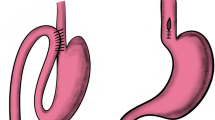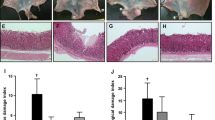Abstract
Background
It has been reported that simvastatin, a statin commonly prescribed for its anti-inflammatory and antioxidant effects, has gastroprotective effects in indomethacin and ethanol-induced gastric ulcers. However, the effects of simvastatin on alendronate-induced gastric mucosal injury remain unexplored.
Aim
This study investigated the use of simvastatin for the treatment of alendronate-induced gastric ulcers in rats.
Methods
Female rats were pretreated with vehicle or simvastatin (20 and 60 mg/kg p.o.). After 1 h, the rats received alendronate (50 mg/kg p.o.). Simvastatin was administered once daily for 7 days, and from the fourth day of simvastatin treatment, alendronate was administered once daily for 4 days. On the final day of treatment, 4 h after alendronate administration, animals were euthanized, their stomachs were removed, and gastric damage was measured. Samples of the stomach were fixed in 10 % formalin immediately after their removal for subsequent histopathological assessment. Unfixed samples were weighed, frozen at −80 °C until assayed for glutathione (GSH), malondialdehyde (MDA), and cytokine levels and myeloperoxidase (MPO) activity. A third group was used to measure mucus and gastric secretion.
Results
Pretreatment with simvastatin prevented alendronate-induced macroscopic gastric damage and reduced the levels of MDA and GSH, TNF-α and IL-1β, MPO activity, and mucus levels, in the stomach.
Conclusions
This study demonstrates the protective effects of simvastatin against alendronate-induced gastric ulceration. Maintenance of mucosal integrity, inhibition of neutrophil activity, and reduced oxidative stress associated with decreased gastric acidity may explain the gastroprotective effects of simvastatin.






Similar content being viewed by others
Abbreviations
- ALD:
-
Alendronate
- DMSO:
-
Dimethyl sulfoxide
- ELISA:
-
Enzyme-linked immunosorbent assay
- GSH:
-
Glutathione
- IL:
-
Interleukin
- MDA:
-
Malondialdehyde
- MPO:
-
Myeloperoxidase
- NO:
-
Nitric oxide
- SIM:
-
Simvastatin
- TNF:
-
Tumor necrosis factor
References
Raisz LG. Pathogenesis of osteoporosis: concepts, conflicts, and prospects. J Clin Invest. 2005;15:3318–3325.
Fleisch H. Bisphosphonates in Bone Disease: From the Laboratory to the Patient. New York: The Parthenon Group; 1997:32–163.
Chestnut CH, McClung MR, Ensrud KE, et al. Alendronate treatment of the postmenopausal osteoporotic woman: effect of multiple dosages on bone mass and bone remodeling. Am J Med. 1995;29:144–152.
Groen PC, Lubbe DF, Hirsch LJ, et al. Esophagitis associated with the use of alendronate. N Engl J Med. 1996;335:1016–1021.
Stein EA. Management of dyslipidemia in the high-risk patient. Am Heart J. 2002;144:43–50.
Beek E, Lowik C, Pluijm G, et al. The role of geranylgeranylation in bone resorption and its suppression by bisphosphonates in fetal bone explants in vitro: a clue to the mechanism of action of nitrogen-containing bisphosphonates. J Bone Miner Res. 1999;14:722–729.
Mundy G, Garrett R, Harris S, et al. Stimulation of bone formation in vitro and in rodents by statins. Science. 1999;286:1946–1949.
Meier CR, Schlienger RG, Kraenzlin ME, et al. HMG CoA reductase inhibitors and the risk of fractures. JAMA. 2000;283:3205–3210.
Wang PS, Solomon DH, Mogun H, et al. HMG-CoA reductase inhibitors and the risk of hip fractures in elderly patients. JAMA. 2000;283:3211–3216.
Scalia R, Gooszen ME, Jones SP, et al. Simvastatin exerts both anti-inflammatory and cardioprotective effects in apoliprotein E-deficient mice. Circulation. 2001;103:2598–2603.
Pruefer D, Scalia R, Lefer AM. Simvastatin inhibits leukocytes–endothelial cell interactions and protects against inflammatory processes in normocholesterolemic rats. Arterioscler Thromb Vasc Biol. 1999;19:2894–2900.
Ungureanu D, Filip C, Artenie A, Artenie R. Evaluation of simvastatin antioxidant effects. Rev Med Chir Soc Med Nat. 2003;107:66–71.
Tariq M, Khan HA, Elfaki I, et al. Gastric antisecretory and antiulcer effects of simvastatin in rats. J Gastroenterol Hepatol. 2007;22:2316–2323.
Heeba GH, Hassan MKA, Amin RS. Gastroprotective effect of simvastatin against indomethacin-induced gastric ulcer in rats: role of nitric oxide and prostaglandins. Eur J Pharmacol. 2009;607:188–193.
Silva RO, Lucetti LT, Wong DVT, et al. Alendronate induces gastric damage by reducing nitric oxide synthase expression and NO/cGMP/KATP signaling pathway. Nitric Oxide. 2014;40:22–30.
Costa NRD, Silva RO, Nicolau LA, et al. Role of soluble guanylate cyclase activation in the gastro protective effect of the HO-1/CO pathway against alendronate-induced gastric damage in rats. Eur J Pharmacol. 2013;700:51–59.
Sedlak J, Lindsay RH. Estimation of total, protein-bound, and nonprotein sulfhydryl groups in tissue with Ellman’s reagent. Anal Biochem. 1968;25:192–205.
Mihara M, Uchiyama M. Determination of malonaldehyde precursor in tissues by thiobarbituric acid test. Anal Biochem. 1978;86:271–278.
Bradley PP, Christensen RD, Rothstein G. Cellular and extracellular myeloperoxidase in pyogenic inflammation. Blood. 1982;60:618–622.
Cunha FQ, Boukili MA, Motta JI, Vargaftig BB, Ferreira SH. Blockade by fenspiride of endotoxin-induced neutrophil migration in the rat. Eur J Pharmacol. 1993;238:47–52.
Laine L, Weinstein WM. Histology of alcoholic hemorrhagic “gastritis”: a prospective evaluation. Gastroenterology. 1988;94:1254–1262.
Corne SJ, Morrissey SM, Woods RJ. Proceedings: a method for the quantitative estimation of gastric barrier mucus. J Physiol. 1974;242:116–117.
Shay H. A simple method for the uniform production of gastric ulceration in the rat. Gastroenterology. 1945;5:43–61.
Jadhav SB, Jain GK. Statins and osteoporosis: new role for old drugs. J Pharm Pharmacol. 2006;58:3–18.
Uzzan B, Cohen R, Nicolas P, et al. Effects of statins on bone mineral density: a meta-analysis of clinical studies. Bone. 2007;40:1581–1587.
Nicolau LAD, Silva RO, Damasceno SRB, et al. The hydrogen sulfide donor, Lawesson’s reagent, prevents alendronate-induced gastric damage in rats. Braz J Med Biol Res. 2013;46:708–714.
Wallace JL, Dicay M, Mcknight W, et al. N-bisphosphonates cause gastric epithelial injury independent of effects on the microcirculation. Aliment Pharmacol Ther. 1999;13:1675–1682.
Ohashi Y, Aihara E, Takasuka H, Takahashi K, Takeuchi K. Antral ulcers induced by alendronate, a nitrogen-containing bisphosphonate, in rat stomachs—prophylactic effect of rebamipide. J Physiol Pharmacol. 2009;60:85–93.
Wallace JL, Ma L. Inflammatory mediators in gastrointestinal defense and injury. Exp Biol Med. 2001;226:1003–1015.
Kanatsu K, Aihara E, Okayama M, Kato S, Takeuchi K. Mucosal irritative and healing impairment action of risedronate in rat stomachs: comparison with alendronate. J Gastroenterol Hepatol. 2004;19:512–520.
Thieabaud D, Sauty A, Burckhard A, et al. An in vitro and in vivo study of cytokines in the acute-phase response associated with bisphosphonates. Calcif Tissue Int. 1997;61:386–392.
Yamaguchi K, Motegi M, Iwakura Y, Endo Y. Involvement of interleukin-1 in the inflammatory actions of aminobisphosphonates in mice. Br J Pharmacol. 2000;130:1646–1654.
Weitz-Schmidt G. Statins as anti-inflammatory agents. Trends Pharmacol Sci. 2002;23:482–487.
Schönbeck U, Libby P. Inflammation, immunity, and HMG-CoA reductase inhibitors: statins as antiinflammatory agents? Circulation. 2004;109:II18–II26.
Sager PT, Melani L, Lipka J, et al. Effect of coadministration of ezetimibe and simvastatin on high-sensitivity C-reactive protein. Am J Cardiol. 2003;15:1414–1418.
Bracht L, Barbosa CP, Caparroz-Assef SM, et al. Effects of simvastatin, atorvastatin, ezetimibe, and ezetimibe+ simvastatin combination on the inflammatory process and on the liver metabolic changes of arthritic rats. Basic Clin Pharmacol. 2012;26:722–734.
Vaananenn PM, Medding JB, Wallace JL. Rol of oxygen derived free radicals in indomethacin-induced gastric injury. Am J Physiol. 1991;261:G470–G475.
Yoshikawa T, Naito Y, Kishi A, et al. Role of active oxygen, lipid peroxidation and antioxidants in the pathogenesis of gastric mucosal injury induced by indomethacin in rats. Gut. 1993;34:732–737.
Chattopadhyay I, Bandyopadhyay U, Biswas K, Maity P, Banerjee RK. Indomethacin inactivates gastric peroxidase to induced reactive-oxygen-mediated gastric mucosal injury and curcumin protects it by preventing peroxidase inactivation and scavenging reactive oxygen. Free Radic Biol Med. 2006;40:1397–1408.
Sener G, Paskaloglu K, Kapucu C, Cetinel S, Contuk G, Ayanoglu-Dulger G. Octreotide ameliorates alendronate-induced gastric injury. Peptides. 2004;25:115–121.
Sener G, Kapucu C, Cetinel S, Cikler E, Ayanoglu-Dulge RG. Gastroprotective effect of leukotriene receptor blocker montelukast in alendronate-induced lesions of the rat gastric mucosa. Prostaglandins Leukot Essent Fatty Acids. 2005;72:1–11.
Wallace JL, Keenan CM, Granger DN. Gastric ulceration induced by nonsteroidal anti-inflammatory drugs is a neutrophil dependent process. Am J Physiol. 1990;259:G462–G467.
Ohashi Y, Aihara E, Amagase K, Takeuchi K. Induction of antral ulcers by alendronate, a nitrogen-containing bisphosphonate, in rat stomachs (abstract). Gastroenterology. 2008;134:A-237.
Szabo S, Trier JS, Frankel PW. Sulfhydryl compounds may mediate gastric cytoprotection. Science. 1981;214:200–202.
Szabo S, Nagy L, Plebani M. Glutathione, protein sulfhydryls and cysteine proteases in gastric mucosal injury and protection. Clin Chim Acta. 1992;206:95–105.
Lichtenberger LM, Romero JJ, Gibson GW, Blank MA. Effect of bisphosphonates on surface hydrophobicity and phosphatidylcholine concentration of rodent gastric mucosa. Dig Dis Sci. 2000;45:1792–1801.
Sener G, Goren FO, Ulosoy NB, Ersoy Y, Arbak S, Dulger GA. Protective effect of melatonin and omeprazole against alendronat-induced gastric damage. Dig Dis Sci. 2005;50:1506–1512.
Peter CP, Handt LK, Smith SM. Esophageal irritation due to alendronate sodium tablets. Dig Dis Sci. 2002;43:1998–2002.
Dobrucki LE, Kalinowski L, Dobrucki IT, Malinski T. Statin-stimulated nitric oxide release from endothelium. Med Sci Monit. 2001;7:622–627.
Jiang JL, Jiang DJ, Tang YH, Li NS, Deng HW, Li YJ. Effect of simvastatin on endothelium-dependent vaso-relaxation and endogenous nitric oxide synthase inhibitor. Acta Pharmacol Sin. 2004;25:893–901.
Kim H, Kim KH. Effects of a nitric oxide donor and nitric oxide synthase inhibitors on acid secretion of isolated rabbit gastric glands. Pharmacology. 1996;53:331–339.
Kato S, Kitamura M, Korolkiewicz RP, Takeuchi K. Role of nitric oxide in regulation of gastric acid secretion in rats: effects of NO donors and NO synthase inhibitor. Br J Pharmacol. 1998;123:839–846.
Berg A, Redeen S, Ericson AC, Sjöstrand SE. Nitric oxide—an endogenous inhibitor of gastric acid secretion in isolated human gastric glands. BMC Gastroenterol. 2004;4:1–9.
Silva RO, Bingana RD, Soares PMG, Souza MHLP, Medeiros JVR. The role of nitric oxide in alendronate-mediated acceleration of gastric emptying and gastrointestinal transit in rats. Afr J Pharm Pharmacol. 2015;9:307–312.
Acknowledgments
The authors gratefully acknowledge the financial support from National Counsel of Technological and Scientific Development—CNPq (Brazil) and Research Foundation for the State of Piauí—FAPEPI.
Author information
Authors and Affiliations
Corresponding author
Ethics declarations
Conflict of interest
None.
Ethical standard
All procedures performed in studies involving animals were in accordance with the ethical standards of the institution or practice at which the studies were conducted.
Rights and permissions
About this article
Cite this article
Carvalho, N.S., Silva, M.M., Silva, R.O. et al. Protective Effects of Simvastatin Against Alendronate-Induced Gastric Mucosal Injury in Rats. Dig Dis Sci 61, 400–409 (2016). https://doi.org/10.1007/s10620-015-3890-7
Received:
Accepted:
Published:
Issue Date:
DOI: https://doi.org/10.1007/s10620-015-3890-7




